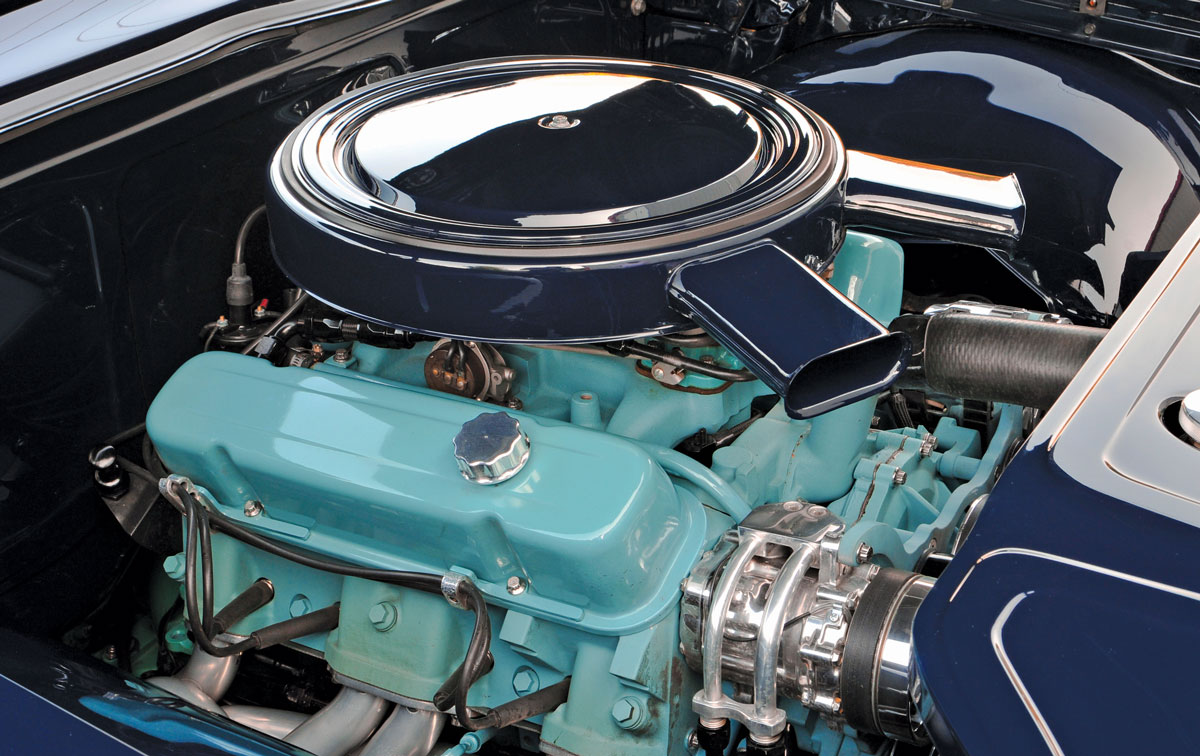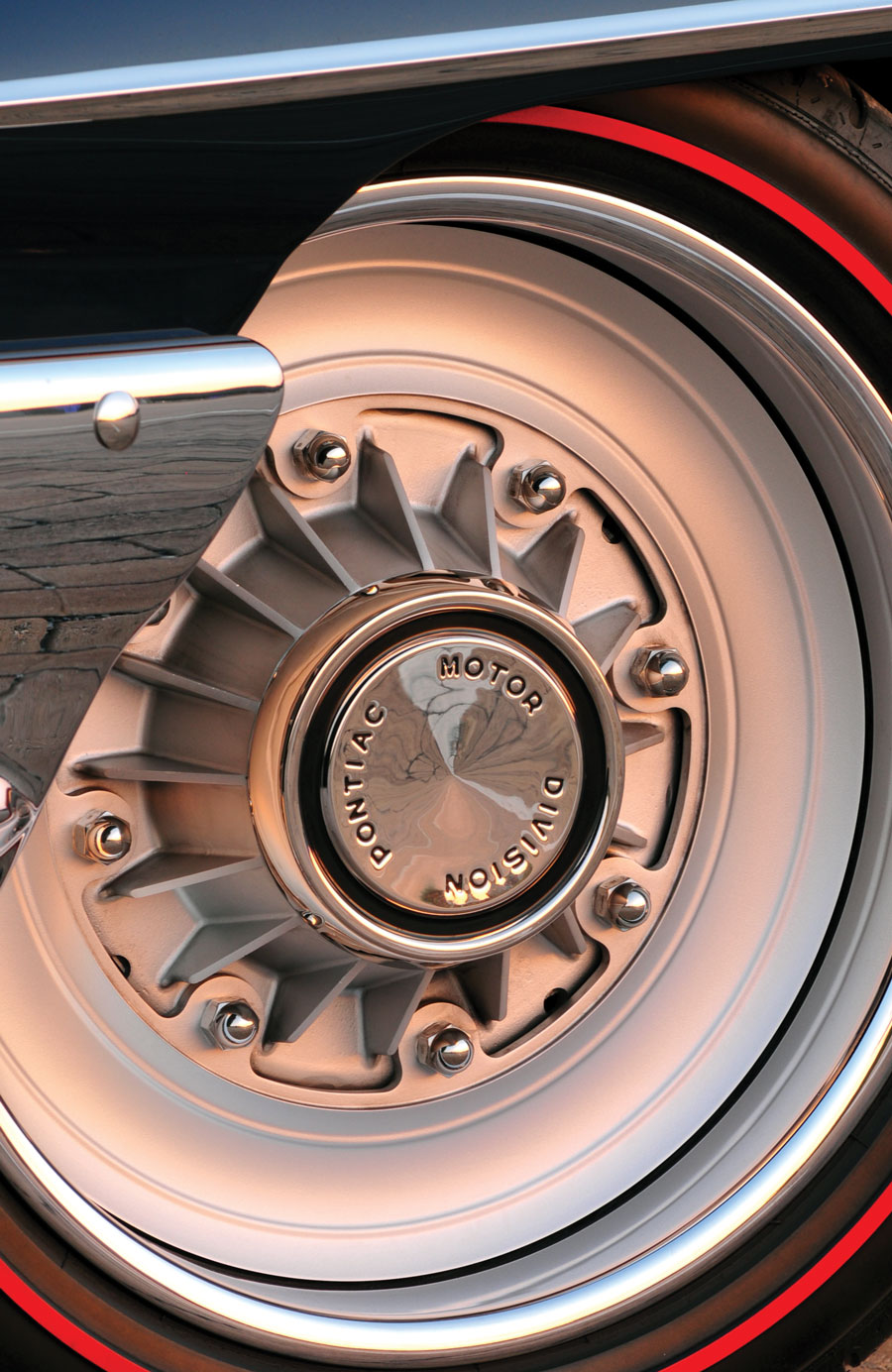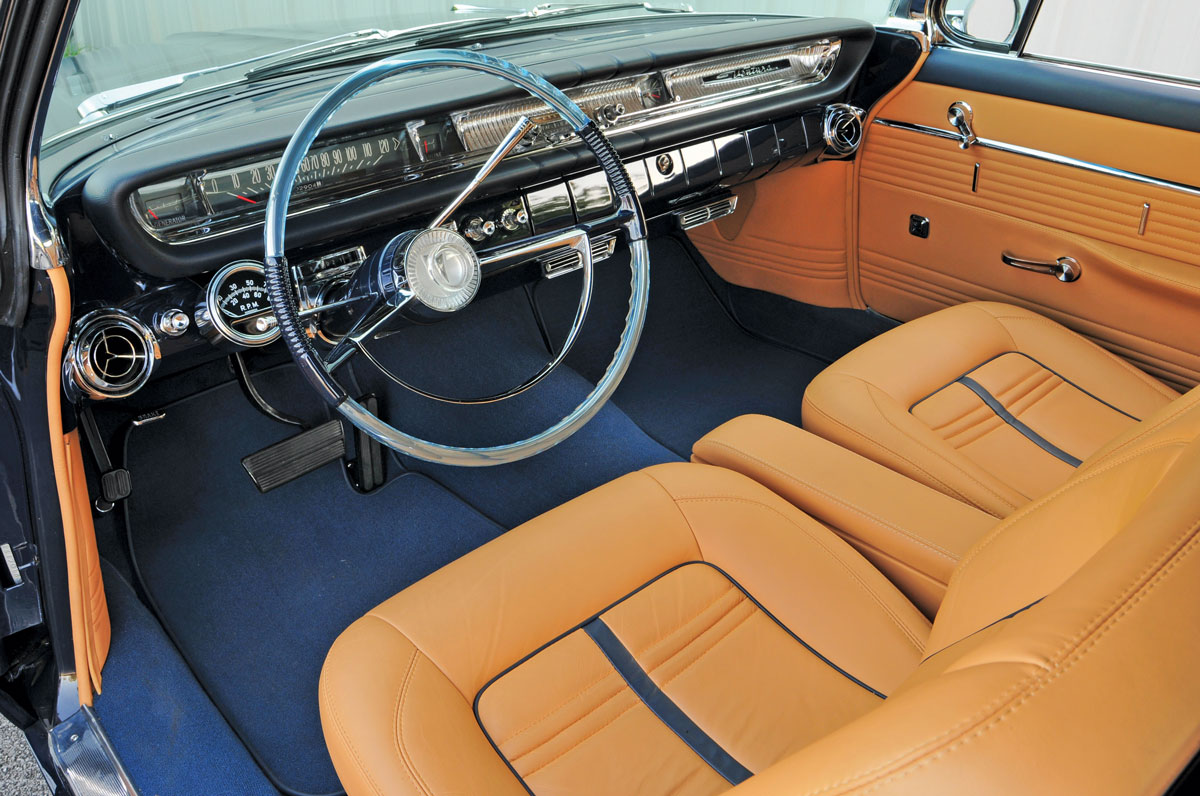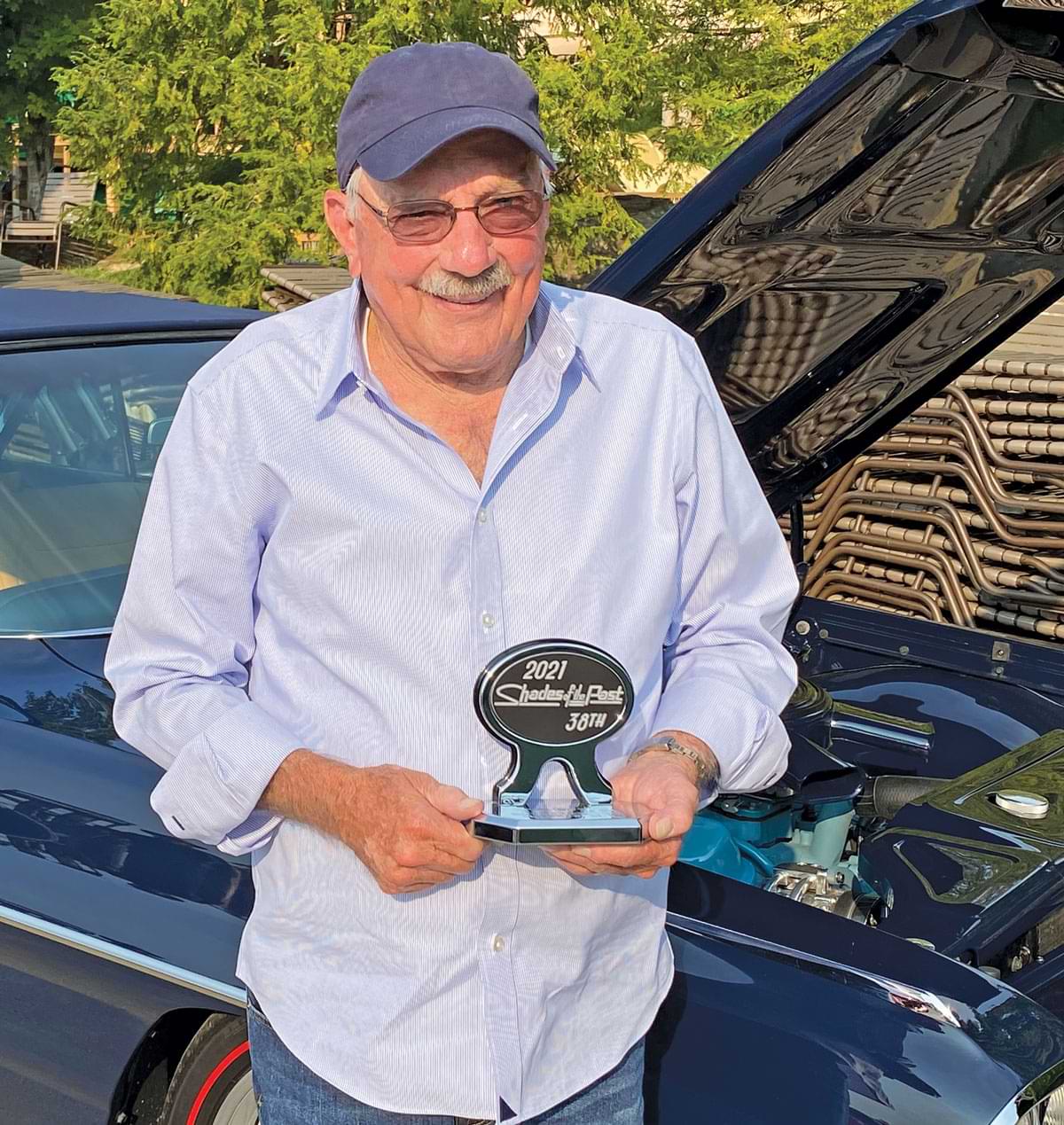
 Photography by Josh Mishler
Photography by Josh Mishleregardless of their heavyweight appearance, the early ’60s Pontiacs have always been viewed as a performance car. Joe Horisk, of Delaware, proves this point with his ’61 Pontiac Catalina convertible. (We will talk about the Ventura badging later.) It’s no wonder as these cars with their potent 389ci (intro 1959) V-8s, later with Tri-power or the 421 SD (intro 1961 as a dealer-installed option) could motorvate massive amounts of sheetmetal. The 421 SD became factory installed in 1962 and in 1963 a street version became available from the factory with a dual four-barrel or three two-barrel setup. There’s a certain mystique about any of the ’60s Pontiacs as they are looked upon favorably by hot rodders. This is especially true for Joe who is drawn to his ’61 Pontiac Catalina convertible, as he considers it one of the best-looking ’60s-era cars.
Upon closer inspection of this drop-top you will undoubtedly recognize the Ventura trim rather than Catalina badging. The Ventura convertible didn’t come upon the scene until 1962. To listen to Joe’s own words: “I put the Ventura trim on the car because I was going to do the tri-color interior as the convertible didn’t come out until 1961. It would have made the car ‘one of none.’” Instead, Joe in the end opted for a custom interior. The Ventura had its own exterior badging, specific wheel covers, and a sport steering wheel, along with the distinctive tri-tone seat covering stitched in Pontiac’s leather-appearing vinyl called Morrokide; you and I might be inclined to call it Naugahyde.
Let’s jump into a bit of a history lesson on the Kelsey-Hayes eight-lug aluminum wheels that first appeared in 1960. Back in the day these wheels made Pontiacs special as they had a real purpose and here we see form following function. While all manufacturers were selling speed, Pontiac also gave serious thought to handling and braking.
Remember the Pontiac ads enlightening all of us on the idea of the “wide track” chassis to promote handling? Well, it was also Pontiac who thought that stopping these high-performance factory hot rods was a good and salable idea. Under the new management team, built around youthful designers and engineers who understood performance (Semon “Bunkie” Knudsen, John Z. DeLorean, and Pete Estes), they began developing GM’s Firebird wheel design with Kelsey-Hayes, their wheel supplier.
What developed was an 11-inch finned aluminum brake drum with a 14×6 steel outer rim. The studs that connect the brake drum and outer rim numbered eight and since these were readily visible chrome-plated acorn nuts were used. It’s here that the “eight-lug” wheel terminology came into being. Form, function, and styling all wrapped up into one package. Improved braking and looks via these wheels were available through the ’68 model year. By 1967, disc brakes had become commonplace and the auto buying public (as well as car guys) preferred this method of braking.
Initially these distinctive wheels cannot be missed when ogling Joe’s ’61 Catalina. The reality is he had these eight-lug wheels custom made at Schott Performance Wheels to look like the originals but made from modern materials and manufacturing techniques. The Schott eight-lug wheels measure 18×7 and 20×9 and are all wrapped with Diamond Back rubber measuring 225/50R18 in front and 245/45R20 in the back. It should be noted that in the front Joe eliminated the “factory” drum portion that would have been an integral part of the original wheel. This was done so that a GM single-large caliper disc brake system could be adapted. Schott made these custom three-piece wheels that allow the wheels to look strikingly like the original eight-lug wheels but increase the diameter from the factory 14-inch diameter to 18 and 20. Schott made the outer hoop and spacer needed to provide a bolt-on surface and increase the diameter.
The ’61 Catalina rides on a 119-inch wheelbase while its bigger brother the Bonneville rode on a 123-inch wheelbase. Joe retained the stock ’61 Catalina frame with the addition of one-off Fatman 2-inch drop spindles (special thanks to the crew at Fatman), lowered coil springs, and a factory 1-1/4-inch sway bar in front. The ’61 Catalina utilizes a stock rearend, which in the day meant it was a Hotchkiss-style utilizing a centersection fitted with a 9.3-inch ring gear and axles that could be easily removed and swapped. By 1961 the rearend had evolved into using limited-slip differentials called Safe-T-Trac and 31-spline axles (up from 29). Joe introduced a few rearend upgrades that include the Ridetech 2-inch lowered coil springs and shocks, 3.64 gears, while the factory sway bar is retained and fresh 2-inch linings for the factory drum brakes are employed. Backed up to the 455 is a Del Trans 200-4R with a 2,800-rpm stall speed converter along with an Inland Empire two-piece driveshaft.



We’ve mentioned that Pontiac has a long and storied history of performance so it shouldn’t come as any surprise that Joe’s Catalina runs a 455-inch V-8 out of a ’75 Pontiac. The 455 came to life beginning as a 428 fitted with a 4.21-inch stroke and 4.152-inch bore. From here a pair of Edelbrock aluminum heads, Comp Cams Big Mutha Thumpr camshaft, and 10.75:1 compression are all used along with a factory intake. Resting underneath, the factory dual-horn air cleaner is the immensely popular Pontiac Tri-power (3×2) carb setup. Getting this fuel load to fire off is a PerTronix distributor with a Flame-Thrower coil. The headers and exhaust system are all custom made along with the use of a pair of Dynomax mufflers. Other engine accessories include SPAL electric fan, Powermaster alternator and starter, and Billet Specialties Tru Trac serpentine belt system.
The sheetmetal on our Catalina is stock with the addition of Ventura trim and badges. Now would be the time to mention that all of the brightwork inside and out comes through the efforts of Advanced Plating. Before the trim, badges, and all other exterior brightwork is added Manuel Romero supplied the significant number of hours required to get the body “flat” and ready for paint by Eric Annas who applied a commercial BASF basecoat/clearcoat color (non-metallic).
Inside the Catalina interior features a stock dash and refurbished instrumentation with a favorite of any ’60s hot rodder, the “knee-knocker” 8,000-rpm factory steering column-mounted tach. Speaking of the factory column, it is finished off with a factory-correct steering wheel. The hot rod does have A/C and stereo but they are original factory items that are brought back to life by an American Autowire system handled by the staff at Precision Rod & Custom. The ’63 Chevy buckets are used in front along with the factory rear bench all covered in a tan leather with a blue accent. The same tan leather is also used on the door and kick panels by Paul Atkins of Paul Atkins Custom Auto Interiors. While resting in the plush seating Joe’s feet comfortably rest on the blue wool carpeting, also the handiwork of Atkins.
Joe’s ’61 Pontiac Catalina (faux Ventura) is no stranger to the winner’s circle either, having taken home numerous awards. A few of the memorable awards include a Pros Picks, runner-up in SEMA’s Battle of the Builders, Goodguys Top 10, Shades of the Past Top 25, and for a truly noteworthy acknowledgment a Great 8 recognition at the Detroit Autorama.


